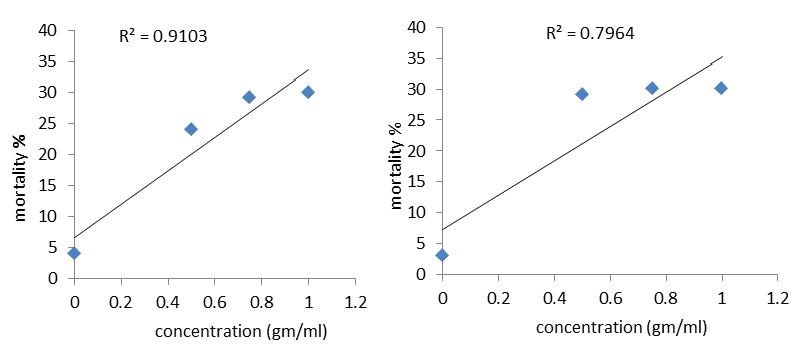Effect of some plant extract on Indian meal moth Plodia interpunctella (Hübner) (Lepidoptera: Pyrallidae) on Pistacio fruits in Erbil-Kurdistan Region
DOI:
https://doi.org/10.21271/ZJPAS.35.5.16Keywords:
KEY WORDS: Stored product pests, Plodia interpunctella (Hübner), Plant extracts, Imature stages.Abstract
In this study the Controlling of imature stages of Indian meal moth, Plodia interpunctella (Hübner) (Lepidoptera- Pyralidae) By botanical control were investigated in laboratory of Agricultural engineering Science Erbil Governorate, Kurdistan Regionon (2022). The natural insecticides (Urtica dioica, Ricinus communis, Lactuca seirola and Cephalaria setosa) were used to control the pest during larval instars. Crude plant extracts (Cephalaria setosa) with the highest mortality rate (73.94) % against the studied larval instar and crude plant extract Ricinus communis with mortality rate 72.27% against the studied larval instars, while in the crude plant extract Urtica diocia was the lowest mortality rate 50.69% against the studied larval stage of P. interpunctella (Hübner
References
Abadia, B., Bartosik, R., (2014). Manual de Buenas Practicas, en Poscecha de
Granos. Hacia el agregado del valor en origen de la production prima. Ediciones INTA, Buenos aires.
Abbott, W. S., (1925). A method of computing the effectiveness of an insecticide. J. Econ. Entomol., 18: 265-267.
Al-Rawi, K. M. and Khalafullah, A. A. M., (1980). Design and Analysis of Agricultural Experiments.Univ. of Mousul.Ministry of higher education and scientific research. Mousul. Iraq. pp.488. (In Arabic).
Arthur, F.H. and Phillips, T.W, (2003). Stored-product insect pest management and control. In: Hui, Y.H., Bruinsma, B.L., Gorham, J.R., Nip, WK., Tong, P.S., Ventresca, P. (Eds), Food Plant Sanitation. Marcel Dekker, New York, pp. 341-358.
Attia, F.I. (1977). Insecticide resistance in Plodia interpunctella (Hubner)(Lepidoptra: Pyralidae) in New South Wales, Australia. Aust.J. entomol. 16,149-152
Kesdek, M.; Kordali, S.; Coban, K.; Ercisli, S. and Usanmaz, A., (2014). Larvicidal effect of some plant, extracts on the pine processionary moth, Thaumetopoeapityocampa (Denis & Schiffermuller) in laboratory conditions Acta Sci. Pol., Hortorum Cultus 13(5): 145-162.
Mbata, G.N.and Shapiro-Ilana, D.I., (2010). Compatibility of Heterorhabditis indica (Rhabditida: Heterorhabditidae) and Habrobracon hebetor (Hymenoptera: Braconidae) for biological control of Plodia interpunctella (Lepidoptera: Pyralidae). Biol.Control 54,75-82.
Kim, H., Yu. Y.S.and Lee, K. Y., (2014). Synergistic effects of heat and
Diatomaceous earth treatment for the control of Plodia interpunctella (Lapidoptera: Pyralidae). Entomol.Res.44,130-136.
Omer, E., (2006). Antifeedant and Toxicity Effects of Some Plant Extracts on Thaumetopoae solitaria Frey. (Lep.: Thaumetopoeidae), Turk J Biol 30: 51-57.
Phillips, T.W., and Thorne, J. E., (2010). Biorational approaches to managing
stored-product insects. Annu. Rev. Entomol. 55,375-397.para granosalma-enados. http://inta.gob.ar/documentos/informacion-sobre-insecticidas-aprobados-para-granos-almacenados.
Rajendran, S.and Sriranjini, V., (2008). Plant products as fumigants for stored product insect contro; J. Stored Prod.Res.44, 126-135.
Rees, D., (2004). Insects of Stored Products.CSIRO Publishing, Collingwood,
Victoria, Australia.
Regnault-Roger, C., (1997). The Potential of botanical essential oils for insect pest control. Integr.Pest Manag.Rev.2,25-34.
Santa Juliana, D.M., (2013). Información sobre insecticidas aprobados
Tripathi, P., Dubey, N. K., (2004). Exploitation of natural products as an alternative strategy to control post-harvest fungal rotting of fruits and vegetables. Postharvest Biol. Technol. 32, 235-245.
Tripathi, A. K., Upadhyay, S., Bhuiyan, M., Bhattacharya, P. R., (2009). A review on pro-apepects of essential oils as biopesticide in insect-pest management. J. Pharmacign. Phytother.1,52-63.
Veena, P., Tripathi, A. K., Aggarwal, K. k.and Khanuja, S.P.S., (2005).
Insecticida L, repellent and oviposition deterrent activity of selected
essential oils Against Anopheles stephensi, Aedes aegypti and Culex
quinquefasciatu tus. Bioresour. Technol. 96, 1749-1757.
Yilmaz, S.; Karaborklu, S.; Azizoglu, U.; Ayvaz, A.; Akbulut, M. and Yildiz,
M. (2013) Toxicity of native Bacillus thuringiensis isolates on the larval
stages of pine processionary moth Thaumetopoea wilkinsoni at different
temperatures, J Agric For 37: 163-172.
Zaitoun, S. T., (2007). The effect of different Mediterranean plant extracts on
the development of the great wax mothGalleria mellonellaL.
(Lepidoptera: Pyralidae) and their toxicity to worker honeybeesApis
melliferaL. (Hymenoptera: Apidae) under laboratory conditions, Food,
Agriculture and Environment (JFAE), Vol. 5(2): 289-294.
Zlatko, J.; Miroslav, K. and Zorica, P., (2007). Grain-protective properties of
herbal extracts against the bean weevil Acanthoscelides obtectus Say,
Industrial Crops and Products 26, 100-104.

Downloads
Published
How to Cite
Issue
Section
License
Copyright (c) 2023 Abdulbaset M. Amin Mohammedamen

This work is licensed under a Creative Commons Attribution 4.0 International License.











